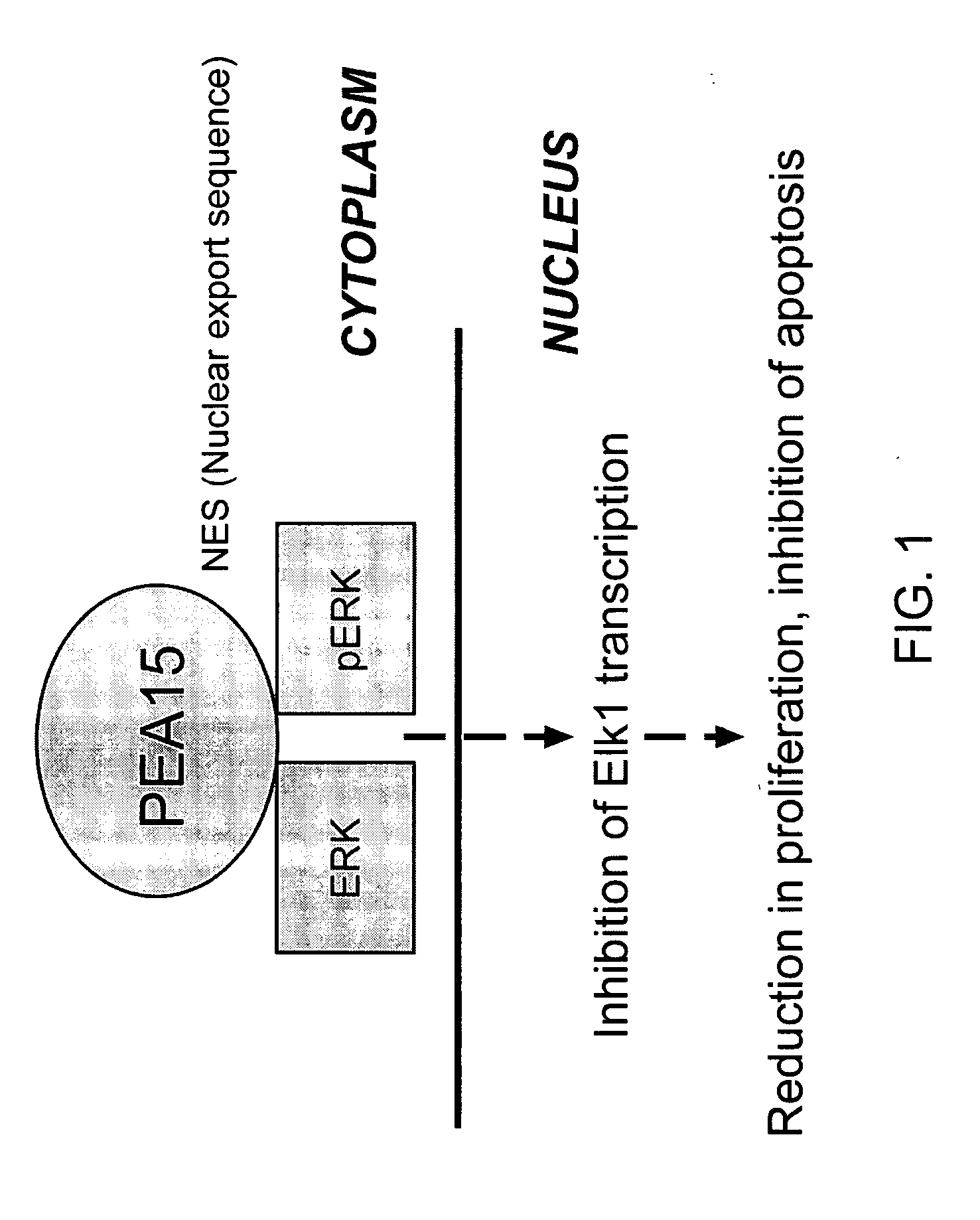Pea15 as a Tumor Suppressor Gene
- Summary
- Abstract
- Description
- Claims
- Application Information
AI Technical Summary
Benefits of technology
Problems solved by technology
Method used
Image
Examples
Example
Example 1
E1A Reduced Proliferation and Induced Apoptosis in Cancer Cells
[0223]This present example demonstrates with the exemplary E1A gene the manipulation of cancer cells to demonstrate cell growth modulation, such as of reduced cell proliferation and induction of apoptosis.
Transfection of E1A into Cancer Cells by Using a Cationic Liposome
[0224]The safety and the efficiency of gene transfer with the DCC-E1A cationic liposome complex was characterized. Eighteen patients were given weekly injections of the DCC-E1A complex through a Tenckhoff catheter placed in either the pleural cavity (for patients with breast cancer) or the peritoneal cavity (for patients with ovarian cancer). The cycles lasted for 4 weeks; each cycle consisted of 3 weekly injections of the DCC-E1A complex followed by 1 week of no injections. During the course of the phase I trial, the E1A gene dose was doubled twice, from 1.8 to 3.6 and then to 7.2 mg / m2 per injection. The median number of injections given to pat...
Example
Example 2
E1A Suppressed Proliferation and Tumorigenicity of Cancer Cells
[0226]As noted elsewhere herein, the precise mechanism by which E1A acts as a tumor suppressor in low-HER2 expressing cells was unclear. To address this issue, the present inventors transfected E1A into the exemplary low-HER2-expressing human ovarian cancer cell line OVCAR3 (OV3) to constitutively express E1A (OV3-E1A) and compared the biological characteristics of the transfectants with those of the parental OV3 cell line (FIG. 4A). The DNA synthesis rate (measured by BrdU incorporation) (FIG. 4B) and anchorage-independent growth of the OV3-E1A cells were both suppressed by 64% relative to the parental cells (P<0.0001) (FIG. 4C). Further experiments with nude mice bearing OV3 cells in the peritoneal cavity confirmed that weekly injections of E1A complexed with DC-Chol cationic liposome (DCC-E1A) resulted in smaller tumors and extended the disease-free survival period (FIG. 4D).
Example
Example 3
E1A-Induced PEA15 Sequesters ERK from Nucleus to Cytoplasm in Cancer Cells
[0227]To further examine reduction of DNA synthesis in OV3 cell contributing to less tumorigenicity, the present investigators further characterized the role of PEA15 in OV3-E1A cells. The present inventors identified PEA15 as a potential target gene of E1A by comparing the gene expression profiles of OV3 and OV3-E1A cells and confirmed that PEA15 levels were much higher in the cytoplasm of OV3-E1A cells than in the cytoplasm of OV3 cells. Because PEA15 blocks ERK-dependent proliferation by binding to activated (phosphorylated) pERK in the cytoplasm and preventing the translocation of that ERK to the nucleus (Formstecher et al., 2001), it was tested whether ERK localization in cytoplasm depended on PEA 15 in E1A-transfected cancer cells. When PEA15 was “knocked down” by siRNA, ERK accumulated in the nucleus instead of the cytoplasm (FIG. 5). These results strongly suggest that sequestration of pERK (a...
PUM
| Property | Measurement | Unit |
|---|---|---|
| Volume | aaaaa | aaaaa |
| Volume | aaaaa | aaaaa |
| Volume | aaaaa | aaaaa |
Abstract
Description
Claims
Application Information
 Login to View More
Login to View More - R&D
- Intellectual Property
- Life Sciences
- Materials
- Tech Scout
- Unparalleled Data Quality
- Higher Quality Content
- 60% Fewer Hallucinations
Browse by: Latest US Patents, China's latest patents, Technical Efficacy Thesaurus, Application Domain, Technology Topic, Popular Technical Reports.
© 2025 PatSnap. All rights reserved.Legal|Privacy policy|Modern Slavery Act Transparency Statement|Sitemap|About US| Contact US: help@patsnap.com



